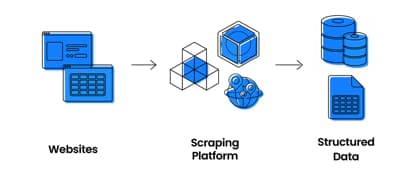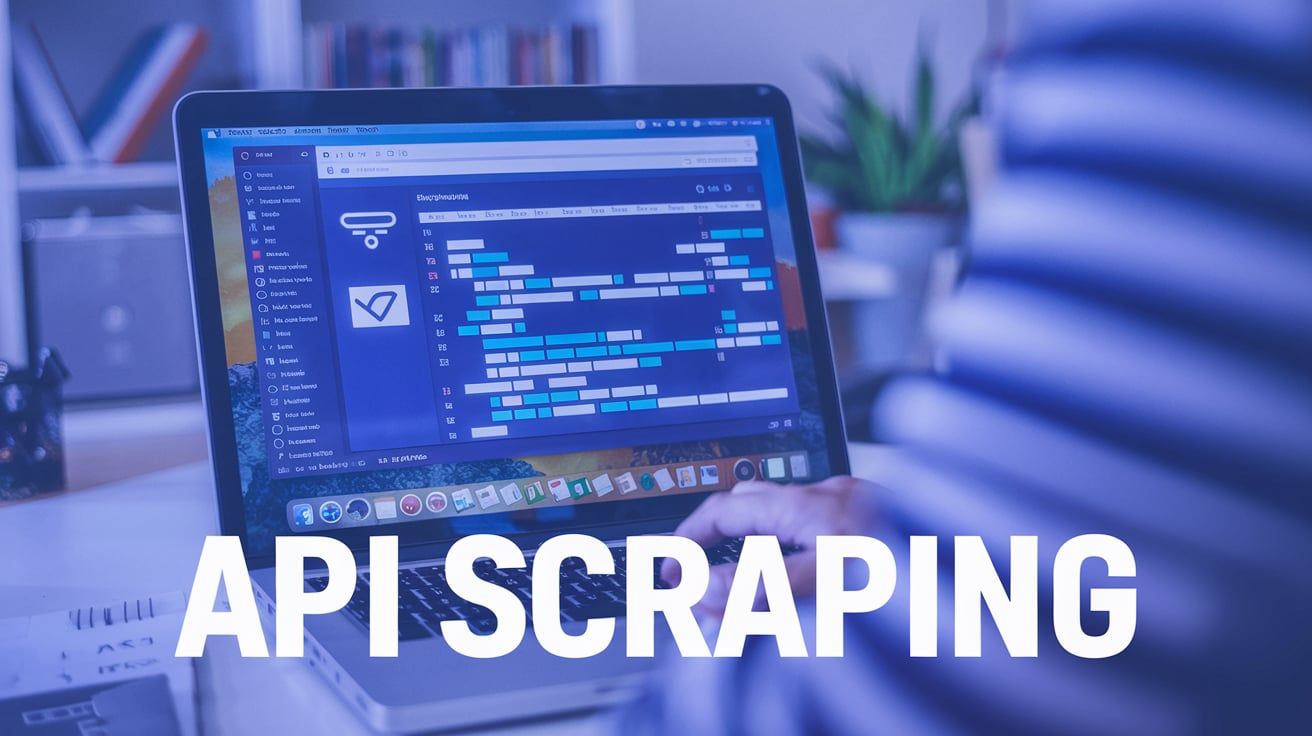In today's data-driven world, extracting information from the web efficiently is crucial for businesses and individuals alike. That's where a web scraping API comes into play, revolutionizing how we gather data from the internet. Unlike traditional methods, it offers a seamless, flexible, and scalable solution for accessing web content without the hassle of managing complex code or infrastructure.

What is API Scraping?
When I step into the tech landscape, one question I often encounter is, "What exactly is API scraping?" Let me clear the air around this concept. API scraping is a technique that leverages web scraping APIs to efficiently extract data from websites. Unlike traditional web scraping methods, which require intricate coding and a deep understanding of the target website's structure, API scraping provides a more straightforward, reliable path to data acquisition.
The beauty of using a web scraping API lies in its flexibility and simplicity. I don't have to worry about the nuances of proxy management or dive into complex coding exercises. With API scraping, sending custom headers or setting geolocation preferences becomes a hassle-free process. All it takes is a simple API call, and I'm set to pull data from any site of my choosing.
Moreover, the scalable nature of web scraping APIs means they're equipped to handle massive volumes of data. This is key for projects that require gathering extensive datasets without worrying about system crashes or data bottlenecks. And because these APIs are typically hosted on scalable infrastructure, they can effortlessly manage large-scale data extraction tasks.
Reliability is another aspect where API scraping stands out. Opting for a web scraping API provided by reputed sources ensures that I'm using a tool designed to tackle various scraping challenges. This translates to fewer breakdowns and consistent data access, making my scraping endeavors more fruitful.
The question of legality often pops up in discussions around web scraping. Here's the good news: API scraping maneuvers within legal boundaries by utilizing its own proxy clusters. This clever move keeps my original IP address shielded, substantially reducing the risk of legal issues tied to unauthorized data access.
While the advantages are clear, it's prudent to also consider potential drawbacks. The restrictions embedded within an API's terms of service could limit how I use the scraped data. Plus, there's always a concern about data misuse, which underscores the importance of adhering to ethical scraping practices.
What Is Web Scraping?
When I first delved into the world of data extraction, the concept of web scraping immediately caught my attention. Web scraping, in essence, is the process of automatically gathering data from websites. This method enables the extraction of vast amounts of information from web pages and presents it in a more accessible format, such as JSON, PDF, or HTML. What makes web scraping particularly intriguing is its versatility; it can be achieved through various programming languages like Python, NodeJs, and Rust, or through specialized data extraction APIs and tools. You might consider the web scraping api services to handle all of it.
Flexibility and Simplicity of Web Scraping
One of the most compelling aspects of web scraping is its flexibility. You're not constrained by the limitations of accessing data through official APIs, which may not always provide the depth of data needed. Instead, web scraping allows for the extraction of any visible web content, even from dynamically loaded websites. Despite its powerful capabilities, starting with web scraping is surprisingly straightforward. Initially, I assumed that intricate coding knowledge was a prerequisite. However, I quickly discovered that with the right tools and a basic understanding of programming concepts, even beginners can extract valuable data from websites.
Web Scraping Use Cases That Inspired Me
Throughout my journey, I've witnessed web scraping being applied in myriad ways. From competitive analysis, market research to real-time data monitoring, the applications are virtually limitless. This adaptability not only demonstrates the utility of web scraping but also highlights its role in various industries seeking data-driven insights.
Now that we've covered the basics of web scraping, let's delve deeper into the intricacies of API scraping, a streamlined approach to efficient data extraction.
Web Scraping vs. API: Which is Best?
When diving into data extraction, understanding the nuances between web scraping and API usage is crucial to selecting the right tool for your needs. Both methods serve the intent of collecting data, but they operate in fundamentally different ways, offering unique advantages based on your project's requirements.
Web scraping is essentially the process of programmatically navigating and extracting data from websites. It doesn't require the website to have an API; hence, it's broadly applicable. When I first ventured into data extraction, web scraping seemed like a magic wand, capable of gathering information from any website I wished to analyze. Its versatility across formats like JSON, HTML, and PDF is particularly beneficial. The primary advantage of web scraping is flexibility. No matter the structure or the site, if the data is visible on the web, it can be scraped. However, this method comes with its challenges, including dealing with complex website structures or the risk of being blocked by web servers.
On the other hand, using an Application Programming Interface (API) is a more streamlined approach to data extraction. APIs are designed to be accessed and ensure reliable, structured data delivery. When available, I've found APIs to be incredibly efficient, allowing for real-time data monitoring and extraction without the overhead of parsing HTML. The benefits of using an API include reliability and efficiency, as it’s designed for machine-to-machine communication and often returns data in a neatly packaged format, making it easier to handle. However, it's worth noting that not all data is accessible via APIs, and usage limits commonly apply.
In my journey, I’ve learned that the choice between web scraping and API scraping hinges on several factors:
- Data Accessibility: If an API is available, it's often the best choice for structured, reliable data. If not, web scraping becomes necessary.
- Flexibility vs. Stability: Web scraping offers more flexibility, whereas APIs provide more stability.
- Legal and Ethical Considerations: Always ensure compliance with a website's terms of service and legal regulations, which might favor one method over the other.
Reflecting on my experiences and the myriad of projects I've worked on, it's clear that both tools have their place in a data scientist's toolkit.
What is API?
Navigating the world of data extraction, I've seen firsthand the pivotal role that both web scraping and API scraping play in harvesting information from the web. Each method has its unique advantages and challenges, making them indispensable tools in a data scientist's arsenal. Whether it's the flexibility and broad applicability of web scraping or the structured and reliable nature of API scraping, the choice ultimately hinges on the specific needs of your project. Remember, staying within the legal boundaries and adhering to website terms is paramount. As we continue to evolve in our data-driven journey, understanding and leveraging these technologies will undoubtedly unlock new insights and opportunities.
Frequently Asked Questions
What does API mean?
API stands for Application Programming Interface. It acts as a contract between two applications, allowing them to communicate by sending requests and receiving responses. This framework is essential for developing software where multiple applications need to interact.
What is the difference between an API user and a scraper?
An API user accesses data through predefined pathways provided by the server, which is efficient and organized. In contrast, a scraper programmatically searches web pages to extract data, a process that can be slower and more cumbersome due to the unstructured nature of the web.
Can a website block your scraping efforts?
Yes, websites can implement measures in their robots.txt file or through other means to prevent scraping. This file, which can be found at http://example.com/robots.txt, contains directives that may disallow scraping either entirely or partially, to maintain site integrity and performance.
What is an API proxy?
An API proxy is an intermediary that sits between the client and the API. It manages the requests and responses between them, offering additional functionality like security measures, caching, and rate limiting, often without altering the original API functionality.
What is an example of scraping?
Scraping can be used for a variety of purposes. A common example is extracting contact information from websites, such as email addresses, for marketing, analysis, or communication purposes. This involves programmatically searching web pages to gather this data.

